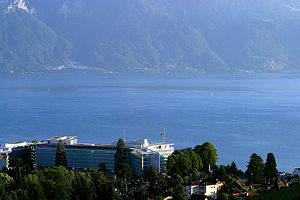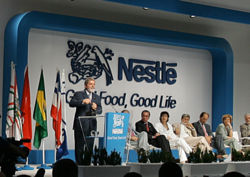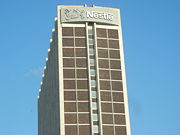Nestlé
2008/9 Schools Wikipedia Selection. Related subjects: Companies
| Nestlé S.A. | |
|---|---|
 |
|
| Type | Public ( SWX: NESN, OTCBB: NSRGY) |
| Founded | |
| Headquarters | Vevey, Switzerland |
| Key people | Henri Nestlé, Founder Peter Brabeck-Letmathe, Chairman & CEO |
| Industry | Food processing |
| Products | Baby food, dairy products, breakfast cereals, confectionery, bottled water, more... |
| Revenue | ▲ 98,5 billion CHF (2006) |
| Net income | ▲ 5,05 billion CHF (2006) 8.8% profit margin |
| Employees | 305,000 (2005) |
| Website | www.nestle.com |
Nestlé is a multinational packaged food company founded and headquartered in Vevey, Switzerland. It results from a merger in 1905 between the Anglo-Swiss Milk Company for milk products established by the Page Brothers in Cham, Switzerland, in 1866 and the Farine Lactée Henri Nestlé Company set up in 1867 by Henri Nestlé to provide an infant food product. Several of Nestlé's brands are globally renowned, which made the company a global market leader in many product lines, including milk, chocolate, confectionery, bottled water, coffee, creamer, food seasoning and pet foods. The company stock is listed on the SWX Swiss Exchange. Some of Nestlé's business practices have been considered unethical, especially the manner in which infant formula has been marketed in developing countries, which led to the Nestlé boycott from 1977.
Pronunciation
Some people in the English-speaking countries pronounce Nestlé's [ˈnɛsəłz], as in the English verb nestle. This was the pronunciation used in company merchandising in the UK for much of the 20th century, e.g. Nestlé's Milkybar. In TV ads in the United States, Nestlé's is pronounced [ˈnɛstliz] or [ˈnɛsliz]. A common pronunciation of Nestlé in Australia is [ˈneslæɪ]. However, the brand is derived from the founder's family name from the French-speaking part of Switzerland, where Nestlé is properly pronounced [nɛst‘le].

International names
China: 雀巢, pinyin - (què cháo) Thailand: เนสเล่
History
Nestlé was founded in 1860. In the 1860s Henri Nestlé, a pharmacist, developed a food for babies whose mothers were unable to breastfeed. His first success was a premature infant who could not tolerate his own mother's milk nor any of the usual substitutes. The value of the new product was quickly recognized when his new formula saved the child's life, and soon, Farine Lactée Henri Nestlé was being sold in much of Europe.
In 1905 Nestlé merged with the Anglo-Swiss Condensed Milk Company. By the early 1900s, the company was operating factories in the United States, United Kingdom, Germany and Spain. World War I created new demand for dairy products in the form of government contracts. By the end of the war, Nestlé's production more than doubled.
The first Nestlé factory to begin production in the United States was opened in Fulton, Oswego County, New York. The factory however was closed in 2001, after the company decided that the cost of restoring, and updating the factory could not financially be justified. Employees of the factory were furious, and raised the company flag upside down the day the closing was announced.
After the war, government contracts dried up and consumers switched back to fresh milk. However, Nestlé's management responded quickly, streamlining operations and reducing debt. The 1920s saw Nestlé's first expansion into new products, with chocolate the company's second most important activity.
Nestlé felt the effects of World War II immediately. Profits dropped from US$20 million in 1938 to US$6 million in 1939. Factories were established in developing countries, particularly Latin America. Ironically, the war helped with the introduction of the company's newest product, Nescafé, which was a staple drink of the US military. Nestlé's production and sales rose in the wartime economy.
The end of World War II was the beginning of a dynamic phase for Nestlé. Growth accelerated and companies were acquired. In 1947 came the merger with Maggi seasonings and soups. Crosse & Blackwell followed in 1950, as did Findus (1963), Libby's (1971) and Stouffer's (1973). Diversification came with a shareholding in L'Oréal in 1974. In 1977, Nestlé made its second venture outside the food industry by acquiring Alcon Laboratories Inc.

In 1984, Nestlé's improved bottom line allowed the company to launch a new round of acquisitions, notably American food giant Carnation and the British confectionery company Rowntree Mackintosh in 1988, which brought the Willy Wonka Brand to Nestlé.
The first half of the 1990s proved to be favorable for Nestlé: trade barriers crumbled and world markets developed into more or less integrated trading areas. Since 1996 there have been acquisitions including San Pellegrino (1997), Spillers Petfoods (1998), and Ralston Purina (2002). There were two major acquisitions in North America, both in 2002: in June, Nestlé merged its U.S. ice cream business into Dreyer's, and in August a US$2.6 billion acquisition was announced of Chef America, Inc. In the same time frame, Nestlé came close to purchasing the iconic American company Hershey's, though the deal fell through. Another recent purchase includes the Jenny Craig fitness firm for US$600 million.
In December 2005 Nestlé bought the Greek company Delta Ice Cream for €240 million. In January 2006 it took full ownership of Dreyer's, thus becoming the world's biggest ice cream maker with a 17.5% market share.
In November 2006, Nestle purchased the Medical Nutrition division of Novartis Pharmaceutical for $2.5B. In April 2007 Nestlé bought baby food manufacturer Gerber for $5.5 billion.
Products
Nestlé has a wide range of products across a number of markets including coffee (Nescafé), water, other beverages, ice cream, infant foods, performance and healthcare nutrition, seasonings, frozen and refrigerated foods, confectionery and pet food. For a list of some of these brands, see List of Nestlé brands.
Business
Management
The executive board, a distinct entity from the board of directors, includes:
- Peter Brabeck-Letmathe, Chairman & CEO
- Carlo Donati, EVP, Chairman, and CEO of Nestlé Waters
- Frits van Dijk, EVP of Asia, Oceania, Africa, Middle East divisions
- Lars Olofsson, EVP of Strategic Business Units and Marketing
- Francisco Castañer, EVP of Pharmaceutical and Cosmetic Products, Liaison with L'Oréal, Human Resources
- Michael Powell, EVP of United Kingdoms Diivision
- Paul Bulcke, EVP of Americas divisions
- Paul Polman, EVP of Finance, Control, Legal, Tax, Purchasing, Export
- Luis Cantarell, EVP of Europe divisions
- Richard T. Laube, Deputy EVP of Nutrition Strategic Business units
- Werner J. Bauer, EVP of Research and Development, Technical, Production, Environment.
Current members of the board of directors of Nestlé are: Günter Blobel, Peter Böckli, Daniel Borel, Peter Brabeck-Letmathe, Edward George, Rolf Hänggi, Nobuyuki Idei, Andreas Koopmann, André Kudelski, Jean Pierre Meyers, Carolina Müller-Möhl, Kaspar Villiger. Secretary to the Board Bernard Daniel.
Nestlé has a good business reputation among Switzerland's largest companies.
Earnings
In 2003, consolidated sales were CHF87.979 billion and net profit was CHF6.213 billion. Research and development investment was CHF1.205 billion.
- Sales by activity breakdown: 27% from drinks, 26% from dairy and food products, 18% from ready-prepared dishes and ready-cooked dishes, 12% from chocolate, 11% from pet products, 6% from pharmaceutical products.
- Sales by geographic area breakdown: 32% from Europe, 31% from Americas (26% from US), 16% from Asia, 21% from rest of the world.
Joint ventures
Nestlé holds 26.4% of the shares of L'Oréal, the world's largest company in cosmetics and beauty. The Laboratoires Inneov is a joint venture in nutritional cosmetics between Nestlé and L'Oréal, and Galderma a joint venture in dermatology with L'Oréal. Others include Cereal Partners Worldwide with General Mills, Beverage Partners Worldwide with Coca-Cola, and Dairy Partners Americas with Fonterra.
Controversy regarding Nestlé
Some of Nestlé's business practices have been controversial, especially the manner in which baby formula has been marketed in developing countries. The controversy ultimately led to the widespread Nestlé boycott, starting in 1977. Nestlé has since launched several Fairtrade products across the world, including Partners Blend in the UK and several grind-at-home Fairtrade coffees in Sweden, which led to a new round of criticism. In December 2007 Nestlé was found guilty of colluding with other milk producers to fix prices in Greece .
Baby milk marketing
Since the late 1970s, Nestlé has attracted much criticism for its baby milk marketing policies in developing countries. This has centered on its apparent recommendations for breastfeeding mothers to switch to its infant formula milk products, leading to the alleged deaths of 15 babies each year as a result of formula being mixed with contaminated water. Nestlé has allegedly violated the widely agreed-upon International Code of Marketing of Breast-milk Substitutes ("International Code"). This led to a boycott coordinated by the International Nestlé Boycott Committee, informed by monitoring conducted by the International Baby Food Action Network. In 1982, Nestlé implemented the International Code in developing countries. The instructions were reviewed and refined in 1984 in consultation with the WHO, UNICEF and the International Nestlé Boycott Committee.
Nestlé itself still advertised breast milk replacements and used pictures of babies in its advertising in 2004. Nestlé has issued instructions to all its offices to ensure strict compliance with the International Code.
Post 2004 allegations of breaches of the International Code continue to be made by campaign organisations, such as IBFAN and the Save the Children Fund (May 2007) and The Guardian newspaper..
Ethiopian government
In December 2002, international aid agency Oxfam revealed that Nestlé was demanding millions of dollars in compensation from Ethiopia. The US$6 million demand was issued for shares in an Ethiopian agricultural firm, which was nationalised by the Marxist Mengistu regime in 1975. Nestlé acquired ELIDCO’s parent company, the Schweisfurth Group, ten years later. Nestlé initially refused the Ethiopian government’s offer of a settlement worth around US$1.5 million (a figure based on the 2002 exchange rate between the dollar and the Ethiopian birr) but insisted on $6m (based on the exchange rate at the time of the nationalization). However, in the face of much public criticism, a statement was issued by Nestlé on December 23, 2002 stating that that they would accept the US$1.5 million and that this money would be made available for famine relief projects in the region in consultation with the International Red Cross and Red Crescent Federation.
Nestlé Purina in Venezuela
In early 2005, Nestlé Purina sold thousands of tons of contaminated animal feed in Venezuela. The local brands included Dog Chow, Cat Chow, Puppy Chow, Fiel, Friskies, Gatsy, K-Nina, Nutriperro, Perrarina and Pajarina. Over 500 dogs, cats, birds and cattle died. It was reported that it was caused by a supplier that had stored corn used in animal food production incorrectly, which led to a proliferation of a fungus with a high quantity of aflatoxin causing hepatic problems in the animals that ate the food. On March 3, 2005, the National Assembly (Venezuela's federal legislature) stated that the company Nestlé Purina was responsible for the quality standards and that compensation must be paid to the owners of the affected animals.
Nestlé water
In Mecosta County, Michigan, United States, a determined citizen coalition has opposed the efforts of a bottled water subsidiary of Nestlé to gain private control of important groundwater supplies. In 2001, the county licensed the company, then a subsidiary of Perrier, to open a bottling plant in Stanwood, Michigan, for a fee of less than US$100 a year. Operating requirements of the factory called for pumping 500,000 gallons (1.9 million litres) of water a day from an aquifer. After learning about the plan, Michigan Citizens for Water Conservation launched a direct action campaign against Nestlé and sought a temporary injunction to halt pumping while the court heard arguments on the legality of Nestlé's use of the water. However, this injunction has not been granted. Nestlé purchased the Calistoga Water Company in 1980. Nestlé Canada is applying for an extension and increase with respect to water bottling activities in the Guelph, Ontario area (2007-05-07)
Genetically modified organisms
In August 2004 a Greenpeace test found genetically modified organisms in Chinese Nesquik. A Chinese woman sued Nestlé since the use of GMOs in that kind of product was prohibited by local law. In December a second test was negative. In November 2005 Nestlé opposed a Swiss ban on GMOs.
Use of forced labour
In April 2004, a Forbes article reported on Nestlé's use of forced labour in the production of their chocolate. According to the article, the International Labor Organisation, part of the UN, estimates that 284,000 child labourers work on cocoa farms in West Africa, mainly in the Ivory Coast. Mars and Hershey's are also being investigated. Global Exchange and the International Labor Rights Fund are taking Nestlé, commodities trader Archer Daniels Midland and Cargill to court in the US under the Torture Victim Protection Act and Alien Tort Claims Act. Nestlé signed an agreement called the Cocoa Protocol to say that it would find a way by July 2005 to certify that chocolate had not been produced by underage, indentured, trafficked or coerced labour. Nestlé has requested that all the coerced child labourers involved in the International Labor Rights Fund lawsuit reveal their names.
Partners Blend
In 2006 Nestle launched its Fairtrade-certified Partners Blend in the UK. The company was accused of greenwashing. Anti-Nestlé campaigners have pointed out that the company has only one Fairtrade product amongst its range of 8,500 and would do better to alter its business practices in the rest of the coffee market (where its Nescafe brand is dominant) than launch a small Fairtrade certified product with limited volume. The Fairtrade foundation countered that this was a turning point for the Fairtrade movement with a major company listening to consumers.
